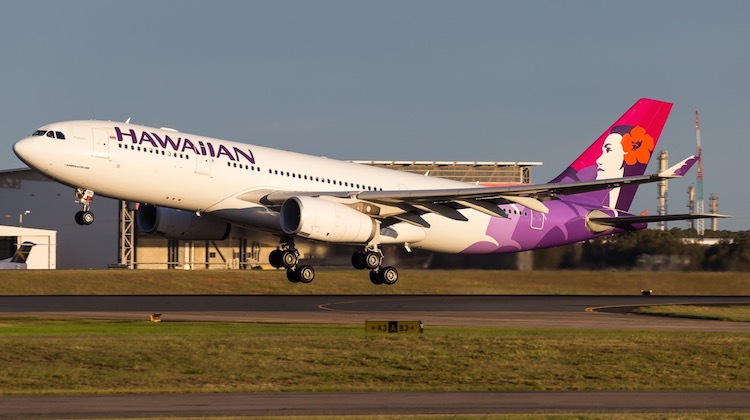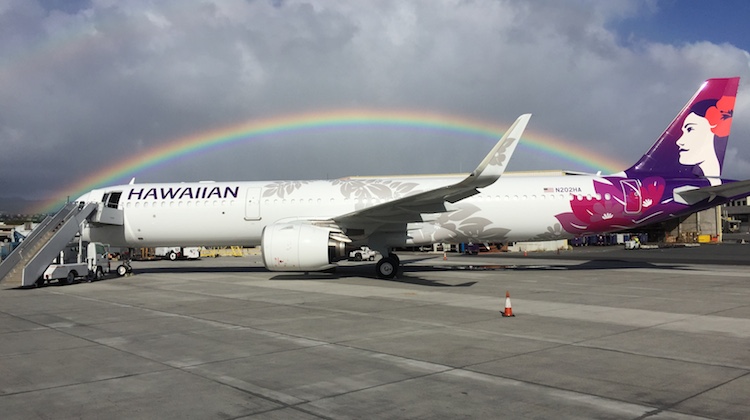
Hawaiian Airlines is well placed to be opportunistic in terms of network expansion in the period ahead given its strong presence in a number of international markets and as it takes delivery of new Airbus A321neos and Boeing 787-9s, chief executive Peter Ingram says.
The Honolulu-headquartered carrier has worked to rebalance its domestic and international networks in recent years to the point where its international flying now generated about a quarter of total revenues, compared with about eight per cent in 2010.
As such, it has built a presence in markets such as Australia, China, Japan and elsewhere that would help facilitate growth should market conditions warrant.
“I think we would be opportunistic about expansion, whether that be frequency or new destinations,” Ingram told Australian Aviation on the sidelines of the International Air Transport Association (IATA) annual general meeting in Sydney in early June.
“If Australia is booming, we are well-positioned in the market, we are poised to capitalise on that.
“If Japan is booming, fantastic, we are well established in Japan, we are known in the market, we’ve got a presence we can grow as we need to.
“If China all of a sudden starts to boom, absolutely we’ve got a presence there. It’s a small one today – three times a week into Beijing – but a lot of the infrastructure has been laid in terms of how to sell in the marketplace.”
In Oceania, Hawaiian Airlines flies to Auckland, Brisbane, and Sydney from its Honolulu hub.
Sydney is served daily, while Auckland has between four and six flights a week depending on the time of year.
Brisbane receives three flights a week. However, this will increase to four flights a week over the summer holiday period between December 2018 and January 2019, Hawaiian announced on June 20.
Ingram described Australia as an important part of Hawaiian’s network, adding that the airline had performed well in this market.
And while Melbourne had been long under consideration as a potential new destination for Hawaiian, Ingram said there was no timeline for adding the Victorian capital to the airline’s network.
“We always have 10 or 15 different routes that we are always looking at and what is at the top of that list at a moment when we’ve got aircraft availability is going to be a function of economic conditions, GDP, competitive environment, all of which is changing all the time,” Ingram said.
“So Melbourne is definitely on that list of cities that we’re evaluating. I don’t have a timeframe to give you on when it is likely to bubble up to the top.”
Ingram said he hoped to grow Hawaiian’s existing partnership with Virgin Australia.
“We’d like to find more opportunities to cooperate with them. Hopefully we will have a chance to do that,” Ingram said.
Currently, Virgin Australia adds its VA airline code on Hawaiian’s flights from Australia to Honolulu, as well as some domestic inter-island flights in Hawaii. There is also a reciprocal frequent flyer agreement for earning and redeeming points, as well as a priority handling and lounge access.
Meanwhile, Hawaiian has interline arrangements with Virgin Australia for domestic flights beyond Brisbane and Sydney.
Hawaiian thrilled with A321neo entry into service
In November 2017, Hawaiian took delivery of its first A321neo, following months of delays due to production issues with the Pratt and Whitney engines.
The larger-capacity, extended-range narrowbody has been used to open up new routes between Hawaii and the United States west coast, as well as replace some widebody services on existing routes.
Further, the use of the A321neo on Hawaii-US west coast routes also freed up widebody aircraft – Hawaiian operates Airbus A330-200s and Boeing 767-300ERs – for potential deployment on long-haul services to Asia, Oceania and deeper into the US mainland.
Hawaiian’s A321neos are configured the aircraft to carry 189 people, with 16 seats in its premium cabin, 44 “extra comfort” seats and 129 economy seats.
By contrast, its A330-200s have 18 lie-flat business class seats, 68 “extra comfort” seats and 192 economy seats for a total of 278. Meanwhile, its 767s have 264 seats (18 business, 246 economy).
“Unlike the big network carriers, we don’t have a lot of feed so we’ve got to rely on these reasonable sized local markets to get in there,” Ingram said.
“Coming now with an airplane that has 189 seats, it opens up some opportunities for things like a Long Beach that we started this week that I don’t think we would have reasonably been thinking about with a widebody aircraft.”

Ingram said the aircraft has performed outstandingly well since its introduction to service.
“One of the great pieces of news is that in operation, we have had absolutely no in-service issues with the airplane or the engines,” Ingram said.
“It has performed right in line with the very high expectations we had in terms of fuel burn and it’s a quiet airplane.
“We expect it to be a great airplane for 25 years so we’re frustrated that the delays have pushed back some of our plans for the summer of this year, but our long-term expectations are as high as they ever were.
“We still expect to have 11 airplanes total by the end of this year, which is what we expected going into the year. They are just going to come a little bit later than we originally thought.”
VIDEO: A look at the inaugural Hawaiian Airlines Airbus A321neo flight, from Hawaiian Airlines’ YouTube channel.
Hawaiian picks 787 for widebody operations
In March, Hawaiian Airlines announced it had dropped plans to operate the Airbus A330-800neo and would instead take delivery of up to 20 Boeing 787-9s.
The aircraft will be powered by General Electric GEnx engines, with deliveries to begin in 2021.
The decision came after Hawaiian went through competitive bid process and review of whether its original order of six A330-800neos still represented the right aircraft for its needs.
After an extensive evaluation of our future fleet needs, we're excited to announce that we've selected the @BoeingAirplanes 787 #Dreamliner to grow our medium to long-haul fleet. As part of the selection, we intend to purchase 10 787-9 jets. #AvGeek #Aviation pic.twitter.com/2Nqve7blLP
— Hawaiian Airlines (@HawaiianAir) March 6, 2018
Ingram said the “purely economic decision” was a very close call.
And while the 787-9’s extra range offered some “opportunities on the edge of the network”, Ingram said it was not as key a consideration as the performance of the aircraft on its major missions.
“As much as that is intriguing as you are going through it, you realise that ultimately over the life of an airplane you’re not going to fly the vast majority of flights on the edge of that range,” Ingram explained.
“If this is going to be the airplane that we are going to fly to Tokyo does it work on Tokyo? Tokyo is likely for the foreseeable future to be a more important destination in our network than whatever that new dot that we don’t fly to yet on the edge of the map is.”
The loss of Hawaiian Airlines’ order leaves the A330-800neo without an airline customer.
Currently, Hawaiian Airlines has 24 Airbus A330-200s and eight Boeing 767s in its fleet. On the narrowbody side it has three A321neos and 20 717s.
While Hawaiian Airlines has not revealed the cabin layout for its 787-9s, Hawaiian has said previously the Dreamliner would be able to carry more passengers than its existing aircraft.










